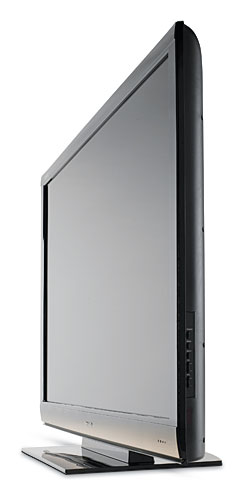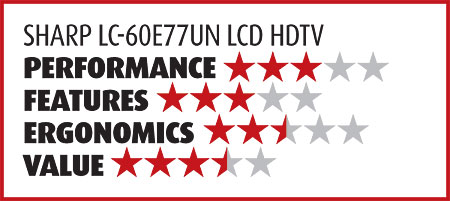Sharp LC-60E77UN LCD HDTV Page 3
Image-wise, the new Star Trek told much the same story. Detail in the Enterprise construction zone as Kirk arrives to enlist was exquisite, and colors were generally bright and vibrant, including the red Corvette. Skintones also looked natural. As before, the black of space wasn’t all that deep, and shadow detail was only so-so.
 I thought the “Deserts” episode of Planet Earth on Blu-ray might be revealing, since there are many shades of brown and orange. These colors looked surprisingly good considering that the TV’s measured yellow point was so far off (see HT Labs Measures). There was no banding as the sun emerges from behind the planet in the opening sequence, probably due in part to the 10-bit panel. Again, detail in things like animal hair and scrub brush was superb, and mountains in the distance were razor sharp. The black of space was deeper than I’ve seen in previous clips, but this was likely due to the fact that the bright Earth occupied a large portion of the image, making space look blacker than it otherwise would.
I thought the “Deserts” episode of Planet Earth on Blu-ray might be revealing, since there are many shades of brown and orange. These colors looked surprisingly good considering that the TV’s measured yellow point was so far off (see HT Labs Measures). There was no banding as the sun emerges from behind the planet in the opening sequence, probably due in part to the 10-bit panel. Again, detail in things like animal hair and scrub brush was superb, and mountains in the distance were razor sharp. The black of space was deeper than I’ve seen in previous clips, but this was likely due to the fact that the bright Earth occupied a large portion of the image, making space look blacker than it otherwise would.
On The Fifth Element Superbit DVD (sent to the TV at 480i), detail was as good as standard def can be. It was certainly not BD quality, but the complex cityscape seen before Leeloo jumps into Korben’s cab was fairly sharp. The color of things like skintones and Korben’s orange T-shirt was fine. I believe the black of space in the movie’s opening shot is higher than normal on the disc, so I can’t fault the TV for this. In fact, the black bars looked blacker than space in those shots.
Before I wrapped up my evaluation, I watched a bit of HD and SD television from DISH Network. I happened to see some night scenes from 10,000 BC on HBO HD, which looked rather flat. On another HBO HD channel, I caught the end of A.I.: Artificial Intelligence, when the aliens bring back David’s mother for a day. Shadow detail in the dark scenes wasn’t great, but brighter daytime scenes were very detailed, with great colors.
When I looked at some SD channels, I discovered that the LC-60E77UN doesn’t have a 4:3 aspect ratio setting, at least via HDMI. Fortunately, the DISH Network receiver has such a setting, so I could see SD channels in their intended aspect ratio. I compared the SD and HD versions of several channels, and the SD version looked significantly softer than HD—a much greater difference than between Blu-ray and DVD, which I attributed to the satellite receiver’s upconversion.
Conclusion
There’s much to like about the Sharp LC-60E77UN, and there’s nothing glaringly wrong. Its color and detail are excellent, as is its video processing. The controls have been improved over the last Sharp LCD HDTV I reviewed, although I really wish the menu would disappear when adjusting a picture control. Also, the black-level is half the value I saw in that previous model. It showed in the improved contrast in scenes with very dark and very bright areas. Still, blacks didn’t appear that deep in normal viewing, and shadow detail was mediocre.
A list price of $3,000 for a 60-inch flat panel is quite good, and I’ve seen this model for less online. If money is tight—a seemingly foregone conclusion these days—but you still want a big flat panel, the LC-60E77UN is a worthy contender.

- Log in or register to post comments





























































